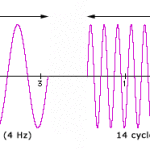Understanding Concert Pitch – What’s It All About?
When the term “concert pitch” is brought up, there seems to be a lot of confusion about what it actually is. Plain and simple, concert pitch is defined as “a universal frequency or note that all instruments are tuned to.” A concert pitch has to be set so instrumentalists can play in tune with one another. Without it, chaos would reign. The article “History of Pitch,” written by piano tuners, gives a brief history as to how concert pitch has evolved over the years. At the end of the article, there’s a list of a variety of concert pitches that have been used. As mentioned, it by no means is an inclusive list. However, it’s easy to see that depending on the year and the region, concert pitch varied greatly until 1939, when it was set to A=440.
What is A=440?
A=440 means that all A’s above middle C are tuned to 440 Hz or, cycles per second. So, 440 Hz is a musical frequency that modern musicians tune their instruments to. From sound frequency, when the frequency gets quite a bit higher than our hearing range, it becomes a color frequency. (A discussion for a later time.) Back to musical frequencies… The notes on a piano are in our best hearing range and modern musical instruments produce notes that are within the range of the 88 notes on a piano keyboard.
 Until mechanical devices were invented, instruments were generally tuned with the aid of tuning forks. This required that the instrument tuner set one pitch (usually A or C) and then the rest of the instrument was tuned from that note. So, when hearing the term A=440, or A=444, or A=432, all that means is the A above middle C is tuned to that particular frequency. All other notes on the instrument are then tuned using that A as a guide.
Until mechanical devices were invented, instruments were generally tuned with the aid of tuning forks. This required that the instrument tuner set one pitch (usually A or C) and then the rest of the instrument was tuned from that note. So, when hearing the term A=440, or A=444, or A=432, all that means is the A above middle C is tuned to that particular frequency. All other notes on the instrument are then tuned using that A as a guide.
Tuning musical instruments
“Standard concert pitch” was set internationally to A=440 in 1939. There are a variety of reasons and theories behind that choice. Some are considered conspiracy theories, which I’ll leave that for you to research on your own. The reason being that they are difficult to prove. Some European countries use both A=442 and A=444 because the sounds are brighter and can be heard more clearly. Lower concert pitches tend to be less “vibrant” and more difficult to hear from further distances. So, in a land where we like to hear our music, it would make sense to have a concert pitch that’s easier to project.
Have you ever attended a band or orchestra concert? Usually the concertmaster (principal violin in orchestra or principal clarinet in bands) stands up and “tunes” the ensemble. He/She will ask the oboist (who has the right of “A”) to play the A. Then, the rest of the ensemble tunes (by sections) to that note. In bands, because brass instruments prefer to tune the open notes, B-flat is often given as the tuning note. The note the ensemble tunes to is called the “concert pitch.”
Frequency equals Hz
 Every note on an instrument has a different frequency (Hz). So, if A=440, then the C above middle C will be C=523 (in our modern equal tempered scale). If the A is adjusted to a different concert pitch, then the C will also change. For example, if A=444, the C an octave above middle C would be C=528. The same is true if you lowered the concert pitch to A=432. The C above middle C would then be C=512. We must remember that this is all based on an equal tempered scale. Equal temperament literally means that the distance from note to note is mathematically equal. However, equal tempered notes are not perfectly in tune because in order to make all the octaves match, notes within the octave have to be adjusted so the octaves are pure. Thirds are the worst in equal temperament. Musicians who can make the adjustment by ear will do so. Unfortunately, keyboard players cannot make adjustments so they have to live with instruments that are never in tune.
Every note on an instrument has a different frequency (Hz). So, if A=440, then the C above middle C will be C=523 (in our modern equal tempered scale). If the A is adjusted to a different concert pitch, then the C will also change. For example, if A=444, the C an octave above middle C would be C=528. The same is true if you lowered the concert pitch to A=432. The C above middle C would then be C=512. We must remember that this is all based on an equal tempered scale. Equal temperament literally means that the distance from note to note is mathematically equal. However, equal tempered notes are not perfectly in tune because in order to make all the octaves match, notes within the octave have to be adjusted so the octaves are pure. Thirds are the worst in equal temperament. Musicians who can make the adjustment by ear will do so. Unfortunately, keyboard players cannot make adjustments so they have to live with instruments that are never in tune.
Over the years, a variety of tuning systems have been used (Pythagorean tuning, mean tone intonation, well-temperament, and just intonation being the most popular methods). Each method adjusts the distance between notes but to the untrained ear, it would be difficult to hear the differences. Our modern western musical scale (starting with the white keys on the piano) has pretty much been intact since the time of Pythagoras (500 BC).
Example of Concert Pitch adjustments
In the article, Ancient Solfeggio Frequencies and Pythagoras, I discuss the frequencies 396, 417, 528, 639, 741, and 852. Because these notes (frequencies) vary greatly in distance from each other, the “concert pitch” for which they use would need to be adjusted. In order to play the Ancient Solfeggio Frequencies on modern western musical instruments (strings and electronic keyboards only), it would be necessary to change the concert pitch for each frequency. The concert pitches required to play these tones vary from A=440 to A=446. Two of the notes would not be possible on keyboard instruments but could be on a string instrument if the player was willing to make major adjustments. In reality, the best method of being able to play all six notes of the Ancient Solfeggio Frequencies scale is to make adjustments electronically for one frequency at a time. Then, repeat five more times for the remaining five frequencies.
Conclusion
Hopefully, this article has provided a better understanding of concert pitch. It’s important to remember that “concert pitch” involves tuning all notes on an instrument after setting the pitch of one note. All other notes are tuned from that starting point. Think of guitar players (and other string players). They often tune the lowest string with a tuner and then the remainder of the higher strings to the lowest string. The lowest string sets the concert pitch.
In western music, there have been a variety of tuning systems over the past 2000 years. Concert pitches varied greatly depending on the region you lived in. I would venture to guess this is part of the reason musicians (prior to standardized tuning) traveled with their own keyboard instruments (piano, harpsichord, etc.). Not knowing what concert pitch another region tuned to, chaos could be created within an ensemble should the concert pitches be different. It would be similar to purchasing a socket set in one city (that matches their own bolts) and only being able to use it in that city because the city 30 miles down the road has differing measurements for their socket sets. Using a bit of common sense, it would only seem natural that musicians would want a standardized system of tuning so they wouldn’t have to purchase an instrument for every region they visited.
As long as there are people, there will be arguments over what is considered a good (or correct) concert pitch. People are different and what may work for one, may not seem sensible or work for another. If you’re happy with a specific concert pitch, this is a great place to share your thoughts and experiences. Please respond in the comment section below.
Here’s a video I made to describe the difference between concert pitch and temperament:
Copyright 2015 by D. Hungerford
[mailerlite_form form_id=2]


[…] questions still need answered. First off, it’s necessary to understand the difference between concert pitch and temperament. If you’re not familiar with those, please read the articles. They are NOT […]